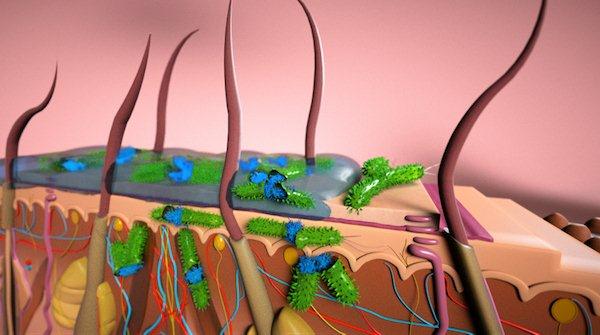Nearly 80 percent of human skin infections can be traced to harmful bacteria huddled beneath a biofilm, a protective layer formed by microorganisms that acts as a shield and makes them resistant to treatment with antibiotics.
In a new study, published in the Proceedings of the National Academy of Science, a team of researchers identified members of a unique class of materials, known as ionic liquids, which can both disrupt biofilms to enhance the delivery of antibiotics and serve as transdermal treatments for serious skin infections.
“Biofilms are inherently very resistant to conventional antibiotics because the molecules have to penetrate into that protective film before they can even encounter the infectious bacteria at all,” said Andy Koppisch, assistant professor of Chemistry and Biochemistry at NAU and co-author of the study. “We found that ionic liquids, which are effectively liquid salts at room temperature, have really interesting properties that other materials don’t—including, in some instances, a strong effect on biofilms.
Koppisch explained the materials are unique in that they can break through the biofilm to deliver antibiotics to kill bacteria encapsulated within it and also act as antibacterial agents themselves. For this reason, the ionic liquids can kill biofilms rapidly, which he said is another novelty of this approach.
Additionally, several of the identified ionic liquids do not cause harm to the skin. They are comprised of GRAS, or generally regarded as safe, molecules that aren’t known to have negative effects in humans. Koppisch said the hope is this will lead to facilitating their development into therapeutics.
Even relatively short two-hour exposures of the ionic liquids to biofilms killed more than 99.9 percent of the bacteria within them, Koppisch said. This is comparable to the treatment of biofilms with bleach, which is the primary means used to sterilize bacterially contaminated surfaces in the laboratory.
According to the study, Koppisch and his colleagues identified choline-geranate as the optimal ionic liquid having biofilm disruptive properties and antimicrobial activity without irritating the skin. The team demonstrated that the compound could both traverse the skin and reduce biofilm-associated bacteria in a model of an infected wound. The compound also was able to deliver an antibiotic through skin.
The team also acquired data that suggests the materials may have useful applications for fighting deadly wound infections such as MRSA and for medical treatments for military warfighters who may be exposed to biological agents in hostile environments.
Koppisch added that developing anti-biofilm compounds is a challenging process for the pharmaceutical community and this approach using ionic liquids is a transformational technology that may aid the development of new antibiotic therapies.
“There is a lot that remains to be explored with these materials, and many new scientific avenues that can be pursued, but our hope is that one day they may be developed into a treatment to aid the medical community and improve people’s lives.”



